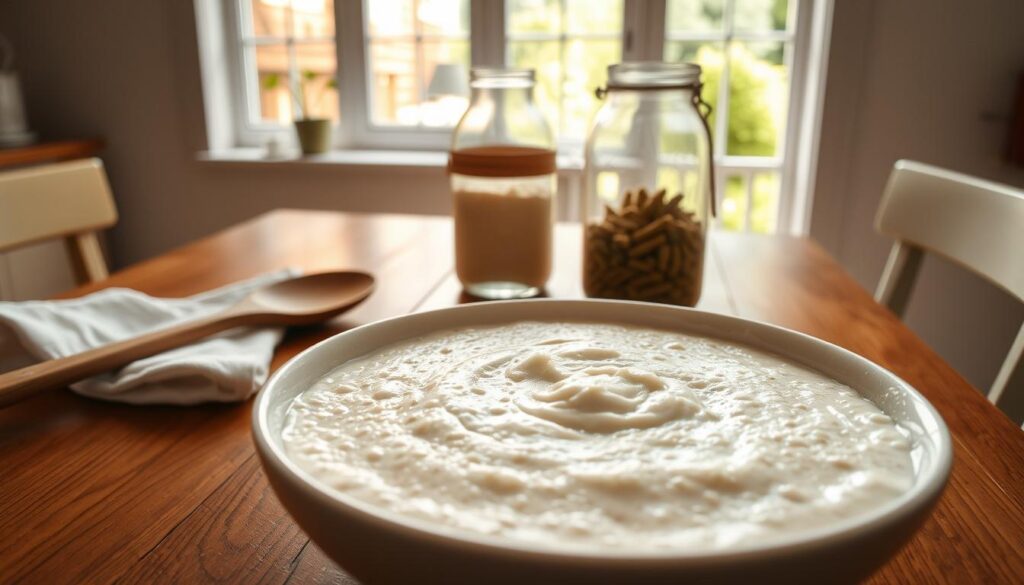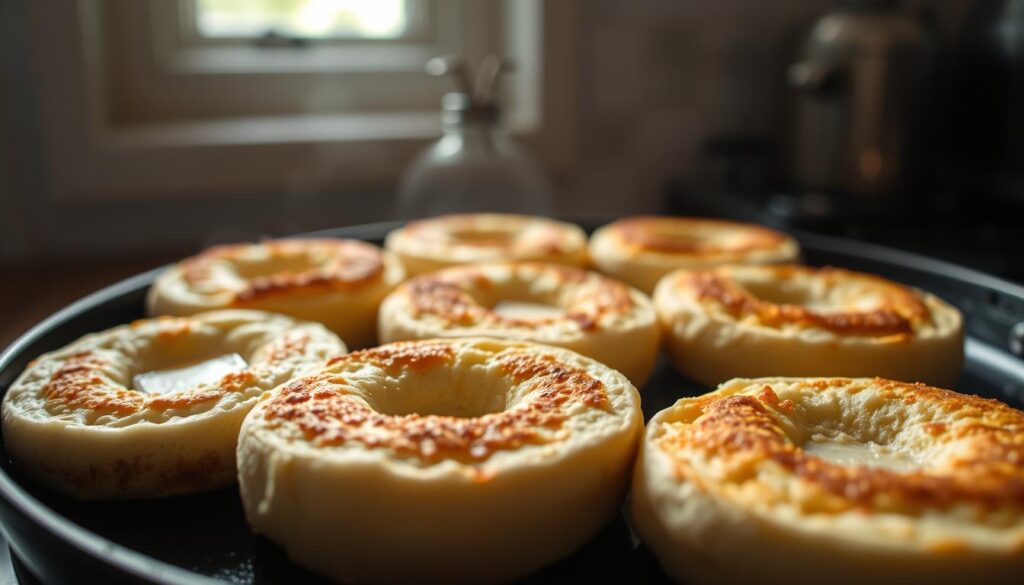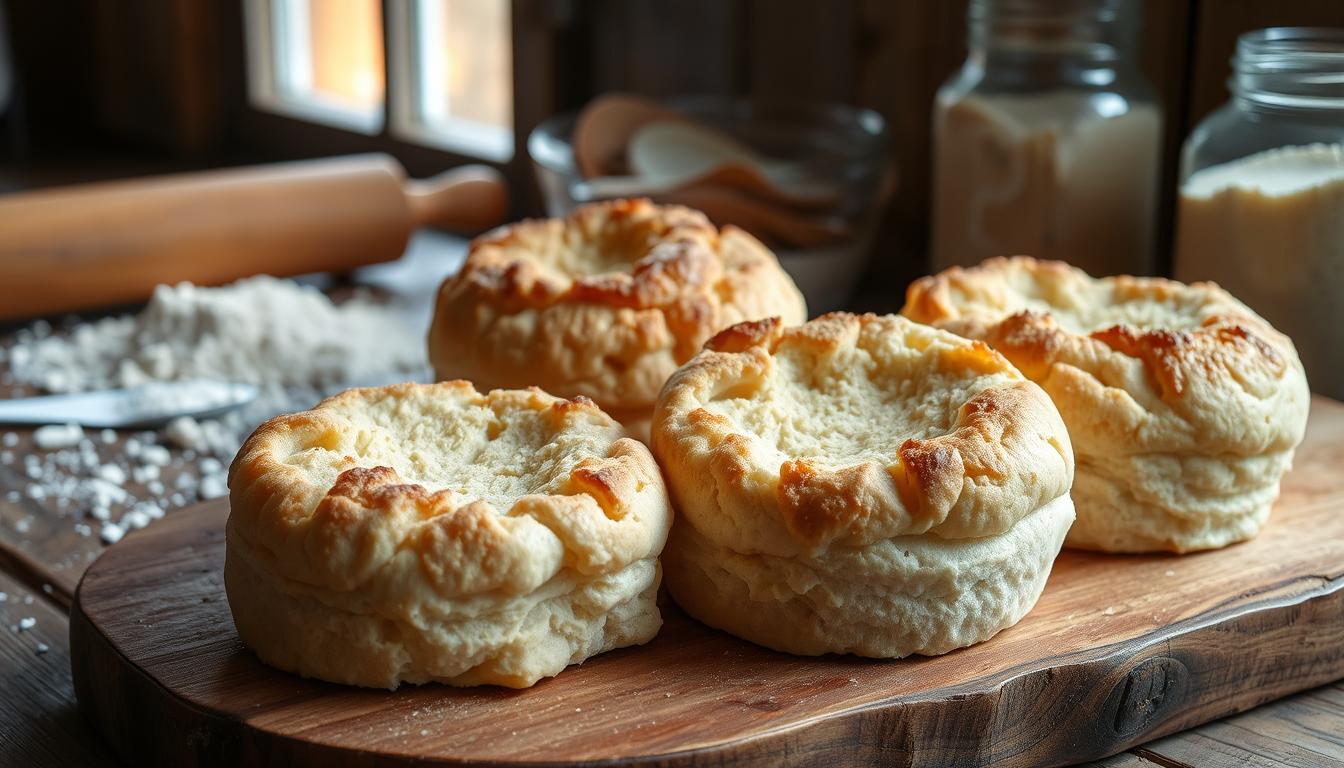Every weekend, my kitchen transforms into a little bread-baking haven. The smell of fresh sourdough English muffins fills the air, and I know I’m about to embark on a delicious adventure—one that store-bought muffins simply can’t match.
There’s something magical about making these from scratch. I watch the dough slowly rise, bubbling with life. When I drop the rounds onto the hot griddle, they sizzle and brown to a beautiful golden color. The best part? That first tear—revealing nooks and crannies just waiting to catch every drop of melted butter. It’s like discovering hidden treasure in every bite.
These muffins aren’t just breakfast. They’re a celebration of simple ingredients, time-honored techniques, and the kind of baking that connects me to the past. I love knowing exactly what goes into them—no preservatives, no mystery ingredients—just flour, water, salt, a little natural leavening, and a whole lot of love.
With a little patience and care, I turn a humble sourdough starter into twelve golden, flavorful muffins. And every single one feels like a small victory. Once you’ve tasted one warm from the pan, you’ll never want to go back. Trust me—your mornings will never be the same.
Table of Contents
The Art of Homemade Sourdough English Muffins
Explore the world of artisan baking and learn to make sourdough English muffins. These breads are more than breakfast – they connect us to bread lore across generations. If you’re wondering if all Sourdough Bread is gluten-free, check out this article.
Sourdough bread has a unique taste that traditional bread can’t match. Its natural fermentation adds depth and complexity, unlike store-bought muffins.
Understanding the Sourdough Difference
Once I started baking with sourdough, I never looked back. There’s something extraordinary about working with a living culture—it’s alive, unpredictable, and full of character. Unlike commercial yeast, my sourdough starter brings:
- Deeper, more complex flavor that evolves over time
- Better digestibility, thanks to natural fermentation
- Longer shelf life without relying on preservatives
- A boost in nutritional value, especially when it comes to minerals and gut-friendly bacteria
Every batch I bake has its own personality, shaped by time, temperature, and care.
Why I Make My Own English Muffins
There’s something deeply satisfying about making English muffins from scratch. When I bake them myself, I get full control over the process. I choose every ingredient, tweak every flavor, and skip all the unnecessary additives. Here’s what I love most:
- Using fresher, better-quality ingredients
- Creating custom flavor profiles, from tangy sourdough to cinnamon-raisin
- Eliminating preservatives and artificial fillers
- Saving money while still baking something bakery-worthy
And the reward? Crisp, golden muffins that taste like they came from a cozy, old-world bakery.
Brief Look Back: The History of English Muffins
English muffins carry a bit of history in every bite. Back in the early 1800s, muffin men walked the streets of England, selling warm muffins door-to-door. You might even remember the “Do you know the Muffin Man?” nursery rhyme—it’s a tribute to this time-honored tradition.
For me, baking these at home is a small way to stay connected to that past. Each muffin I pull from the pan tells a story of craft, patience, and flavor—a delicious link between tradition and today.
When I slice open a freshly baked muffin and see those beautiful nooks and crannies, I’m reminded why I keep baking. It’s not just about the bread—it’s about slowing down, embracing tradition, and enjoying every bite of something I made with my own hands.
Essential Ingredients for Perfect Sourdough English Muffins
Making sourdough English muffins is all about the right ingredients. Your sourdough starter is key, adding flavor and texture to these breakfast favorites.
Here are the must-haves for making great sourdough English muffins:
- Active Sourdough Starter: The heart of your muffins, giving them a tangy taste and rise
- All-purpose flour: 3 cups for the perfect texture
- Room temperature milk: 1 cup for softness
- Melted butter: 1 tablespoon for richness
- Honey: 1 tablespoon for a hint of sweetness
- Salt: 1 teaspoon for a balanced taste
Your sourdough starter should be 100% hydration, with equal parts water and flour. Make sure it’s active and bubbly before you start. These ingredients mix to create a complex flavor that makes these breakfast treats special.
Choosing top-notch ingredients is key. Fresh, room-temperature ingredients help your sourdough starter work its magic. This results in English muffins with the perfect nooks and crannies.
Pro tip: Always use a well-fed sourdough starter that has been refreshed 4-12 hours before baking for optimal results.
Preparing Your Active Sourdough Starter
Creating a vibrant sourdough starter is key to making delicious English muffins. It starts with understanding the balance of microorganisms that make your dough come alive.

A healthy sourdough starter turns simple ingredients into amazing bread. Here’s what you need to know about caring for your starter:
Feeding Schedule for Optimal Results
Keeping your sourdough starter healthy means regular care. Follow these steps:
- Feed your starter at the same time each day
- Use a 1:1:1 ratio of starter, flour, and water
- Keep starter at room temperature (70-75°F)
- Discard half the starter before each feeding
Testing Starter Readiness
Knowing when your sourdough starter is ready for baking involves a few signs:
- Doubling in size within 4-8 hours after feeding
- Exhibiting numerous bubbles throughout
- Displaying a pleasant, slightly tangy aroma
- Passing the “float test” – a spoonful should float in water
“A mature starter is your passport to incredible baked goods!” – Artisan Baker’s Wisdom
Maintaining Starter Health
Your sourdough starter needs regular care to stay active and healthy. Store it in a clean glass container, use unbleached flour, and keep it well-hydrated. If you bake less often, store it in the fridge and feed it once a week.
With dedication and practice, you’ll have a thriving sourdough starter. It will be the secret ingredient in your homemade English muffins.Step-by-Step Mixing and Fermentation Process
Making sourdough English muffins is all about the fermented dough process. It starts with mixing ingredients to create rich flavors. These flavors make homemade muffins truly special.
The mixing process needs precise measurements and careful technique. You’ll mix the following key ingredients:
- 500g all-purpose flour
- 75g active sourdough starter
- 245g milk
- 120g water
- 56g unsalted butter
- 24g sugar
- 9g fine sea salt
Pro tip: Ensure all ingredients are at room temperature for optimal fermentation. Mix the wet and dry ingredients well. This creates a smooth, elastic dough that feels soft and supple.
The fermentation process is where the magic happens. After mixing, let the dough rest for 30 minutes at room temperature. Then, start the bulk fermentation, which takes 8-10 hours at around 70°F. During this time, your dough will develop complex flavors and rise a lot.
“Patience is the secret ingredient in perfect sourdough,” says professional baker Sarah Thompson.
After the initial rise, refrigerate the dough overnight. This cold fermentation develops deeper flavors and makes the dough easier to handle. When you’re ready to shape your English muffins, remove the dough and let it sit at room temperature for about an hour.
Shape the dough into rounds about 1/2-inch thick, dust with cornmeal, and prepare for cooking. Your careful fermentation process will reward you with English muffins boasting incredible taste and texture.
Shaping and Cutting Your English Muffins
Making the perfect English muffin is all about precision in shaping. It’s a journey from dough to muffin, needing the right tools and technique.
The shaping stage is crucial in your English muffin making. You aim for uniform, tasty muffins that will wow your breakfast guests.
Essential Tools for Muffin Shaping
- 3-inch round cookie cutter or biscuit cutter
- Rolling pin
- Cornmeal for dusting
- Large flat surface for rolling
- Parchment paper
Thickness and Size Guidelines
Roll your dough to about 1/2 to 3/4 inch thick. This thickness helps create the nooks and crannies we love in English muffins.
“Precision in shaping is the secret to perfect English muffins.” – Artisan Baking Experts
Here’s how to shape your muffins perfectly:
- Dust your work surface with cornmeal
- Gently roll out the fermented dough
- Use a 3-inch cutter to create uniform circles
- Place cut muffins on a cornmeal-dusted parchment paper
- Allow muffins to rest for 1 hour before cooking
After shaping, you’ll have 8-10 muffins. They’re now ready to become a delicious breakfast treat.
Mastering the Cooking Technique

Cooking sourdough English muffins needs precision and skill. The secret to perfect breakfast breads is mastering the griddle technique. Use a cast-iron skillet or electric griddle at the right temperature.
First, prepare your cooking surface. Sprinkle a lot of cornmeal on the griddle to prevent sticking. It also adds a nice texture to your muffins. The best cooking temperature is 350°F, for even browning without burning.
- Preheat your griddle or skillet to medium-low heat
- Dust surface with yellow cornmeal
- Cook muffins for 8-10 minutes per side
- Look for golden-brown coloration
Your sourdough English muffins should be about 3 to 3.5 inches in diameter. Place them carefully on the heated surface, leaving enough space. Don’t press down on the muffins while cooking.
| Cooking Parameter | Recommended Setting |
|---|---|
| Griddle Temperature | 350°F |
| Cooking Time per Side | 8-10 minutes |
| Muffin Size | 3-3.5 inches |
Watch for visual cues that show your muffins are ready. The edges will start to look dry, and the bottom will be golden-brown. Flip only once to keep the muffin’s delicate structure and ensure even cooking.
Creating Those Famous Nooks and Crannies
For me, the real magic of an English muffin lies in its nooks and crannies—those golden little pockets that hold melted butter, jam, or honey like tiny flavor traps. Achieving that iconic texture isn’t just luck—it’s all about technique and precision.
Mastering Temperature for Perfect Texture
I’ve learned that temperature control is everything when it comes to getting those signature pockets. I cook my muffins on a griddle set to a steady 275°F. Too hot, and the outside burns before the inside cooks. Too low, and they dry out. But at 275°F, the muffins puff beautifully, forming those airy pockets that make each bite so satisfying.
Pro tip: I cook each side for about 8–10 minutes, flipping halfway through. When the center reaches 210°F, I know they’re done—perfectly cooked through with a tender, open crumb.
The Art of Fork-Splitting
This part never gets old. Once the muffins cool slightly, I grab a fork—not a knife. The traditional fork-split method is key to keeping that airy interior intact.
Here’s how I do it:
- Let the muffin rest just long enough to handle
- Insert a fork into the side, working around the entire edge
- Gently pull the muffin apart to reveal those beautiful nooks and crannies
Using a knife just flattens them. The fork teases them open, preserving all that gorgeous texture.
There’s something deeply satisfying about breaking open a freshly made English muffin, watching the steam rise, and seeing those little craters just waiting to soak up butter. It’s the kind of simple joy that makes homemade baking so rewarding.
Once you get the hang of the heat and the fork technique, you’ll never settle for store-bought again. Trust me—your mornings will thank you.
Storage and Serving Suggestions
Your homemade sourdough English muffins need the right care to keep their great taste and texture. These breakfast breads are perfect for many serving ideas.
For a short time, store them in an airtight container at room temperature. They’ll stay fresh for 2-3 days. If you have more, freezing is a great way to keep them.
Freezing and Preservation Techniques
- Wrap individual muffins in plastic wrap or parchment paper
- Place wrapped muffins in a freezer-safe bag
- Store in the freezer for up to 2 months
- Thaw at room temperature or toast directly from frozen
Creative Serving Ideas
Your breakfast breads can be served in many ways:
- Classic Breakfast: Toasted with butter and jam
- Savory Option: Eggs Benedict base
- Quick Lunch: Mini sandwich with ham and cheese
- Sweet Treat: Topped with honey and ricotta
To reheat, use a toaster or skillet. This brings back their crispy outside and soft inside. Your sourdough English muffins show off the skill of artisan baking, bringing restaurant-quality taste to your kitchen.
Conclusion
Making homemade sourdough English muffins is more than a cooking adventure. It’s a delicious skill that changes your breakfast routine. By mastering these artisanal sourdough English muffins, you open a world of fresh, flavorful bread.
Your journey to making homemade bread needs patience, practice, and passion. Each batch of sourdough English muffins is a personal culinary achievement. The techniques you’ve learned will help you make consistently delightful breakfast treats.
Remember, every home baker starts somewhere. Don’t get discouraged by initial imperfections. Your skills will get better with each try, and soon you’ll make sourdough English muffins that impress everyone. Enjoy the process, try new techniques, and savor the delicious results of your homemade bread craftsmanship. Fore more breakfast recipes, check out this cinnamon roll breakfast casserole or these egg-free breakfast recipes.
We invite you to share your sourdough English muffin experiences, challenges, and triumphs. Your baking journey is unique, and we can’t wait to hear about the delicious memories you’ll create in your kitchen.
PrintHomemade Sourdough English Muffins – Soft, Fluffy & Flavorful!
Learn how to make delicious sourdough English muffins with a crisp exterior, soft chewy center, and those signature nooks and crannies! This recipe uses natural fermentation for enhanced flavor and texture. Perfect for breakfast, sandwiches, and eggs Benedict!
- Prep Time: 30 minutes
- Bulk Fermentation: 8 hours
- Cook Time: 16 minutes
- Total Time: 8 hours 46 minutes
- Yield: 8 1x
- Category: Breakfast
- Method: Baking
Ingredients
- 500g all-purpose flour
- 75g active sourdough starter
- 245g milk (room temp)
- 120g water (room temp)
- 56g unsalted butter (softened)
- 24g sugar
- 9g fine sea salt
Instructions
Step 1: Mixing & Kneading
- Ensure all ingredients are at room temperature for better fermentation.
- Mix all ingredients in a large bowl until a shaggy dough forms.
- Knead for 8-10 minutes until the dough becomes soft and elastic.
Step 2: Bulk Fermentation
- Cover the dough and let it rest for 30 minutes at room temp.
- Bulk ferment for 8-10 hours at 70°F (21°C).
Step 3: Cold Fermentation (Overnight)
- After bulk fermentation, refrigerate the dough overnight (8-12 hours).
Step 4: Shaping the Muffins
- Remove dough from fridge and let it sit for 1 hour at room temp.
- Roll dough to ½ to ¾-inch thick.
- Use a 3-inch round cutter to cut muffins.
- Place on a cornmeal-dusted baking sheet.
- Let them rest for 1 hour before cooking.
Step 5: Cooking on the Griddle
- Preheat griddle or skillet to 350°F (medium-low heat).
- Dust with cornmeal to prevent sticking.
- Cook muffins 8-10 minutes per side, until golden brown.
- Muffins should reach an internal temperature of 210°F.
Step 6: Fork Splitting & Serving
- Cool slightly, then fork-split to reveal nooks and crannies.
- Serve toasted with butter, jam, or as a sandwich base!
Notes
Temperature is crucial for the signature texture of English muffins. Cook your muffins at a consistent 275°F.
Nutrition
- Serving Size: 1
- Calories: 180kcal
- Sugar: 2g
- Sodium: 220mg
- Fat: 5g
- Saturated Fat: 2.5g
- Carbohydrates: 30g
- Fiber: 1g
- Cholesterol: 10mg


